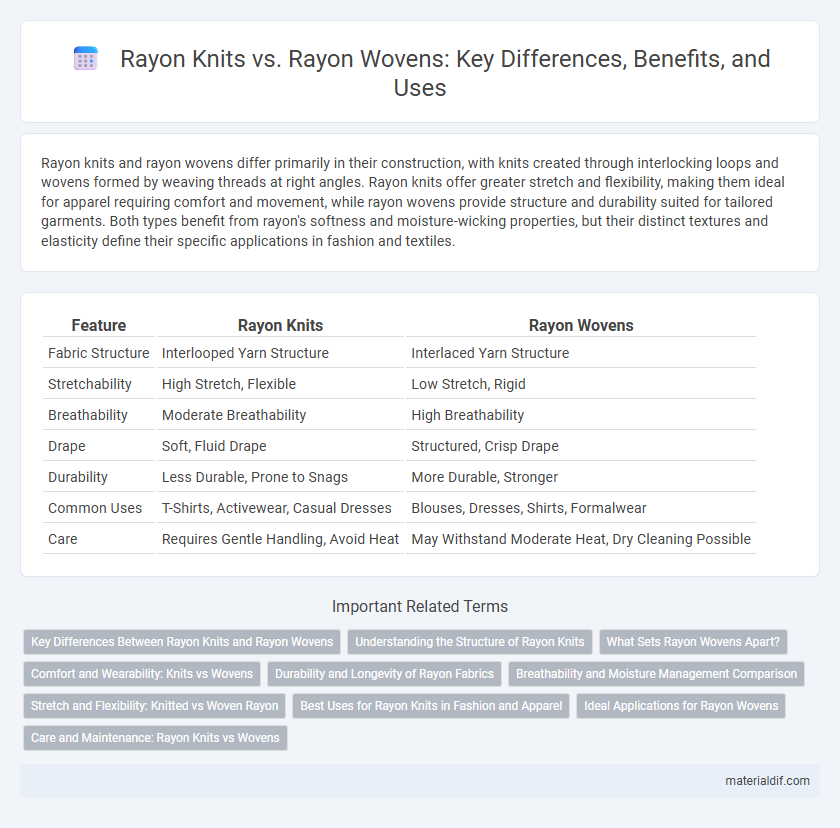Rayon knits and rayon wovens differ primarily in their construction, with knits created through interlocking loops and wovens formed by weaving threads at right angles. Rayon knits offer greater stretch and flexibility, making them ideal for apparel requiring comfort and movement, while rayon wovens provide structure and durability suited for tailored garments. Both types benefit from rayon's softness and moisture-wicking properties, but their distinct textures and elasticity define their specific applications in fashion and textiles.
Table of Comparison
| Feature | Rayon Knits | Rayon Wovens |
|---|---|---|
| Fabric Structure | Interlooped Yarn Structure | Interlaced Yarn Structure |
| Stretchability | High Stretch, Flexible | Low Stretch, Rigid |
| Breathability | Moderate Breathability | High Breathability |
| Drape | Soft, Fluid Drape | Structured, Crisp Drape |
| Durability | Less Durable, Prone to Snags | More Durable, Stronger |
| Common Uses | T-Shirts, Activewear, Casual Dresses | Blouses, Dresses, Shirts, Formalwear |
| Care | Requires Gentle Handling, Avoid Heat | May Withstand Moderate Heat, Dry Cleaning Possible |
Key Differences Between Rayon Knits and Rayon Wovens
Rayon knits feature a looped construction that provides superior stretch, flexibility, and breathability, making them ideal for activewear and casual apparel. Rayon wovens exhibit a crisscross yarn structure resulting in a more stable, less stretchy fabric perfect for tailored garments and structured designs. The primary difference lies in the fabric's elasticity and drape, with knits offering comfort and softness, while wovens deliver durability and form.
Understanding the Structure of Rayon Knits
Rayon knits feature a looped yarn construction, providing enhanced elasticity and breathability compared to rayon wovens, which are formed by interlacing yarns at right angles for a more rigid and stable fabric. The knit structure allows rayon fibers to stretch and recover, making them ideal for garments requiring flexibility and comfort such as t-shirts and activewear. Understanding the structural differences highlights why rayon knits offer superior softness and drape, while rayon wovens excel in durability and shape retention.
What Sets Rayon Wovens Apart?
Rayon wovens feature a tighter weave structure compared to rayon knits, resulting in a more durable and stable fabric ideal for tailored garments and formal wear. Their smooth surface and ability to hold shape make them perfect for precise patterns and sharp designs. Rayon wovens also offer superior breathability and moisture absorption, enhancing comfort in warm climates.
Comfort and Wearability: Knits vs Wovens
Rayon knits offer superior stretch and breathability, enhancing comfort for active wear and casual garments due to their looped construction. Rayon wovens provide a smoother, more structured feel, ideal for formal attire but may lack the flexibility and ease of movement found in knits. The choice between the two depends on the desired balance between softness, stretch, and garment shape retention.
Durability and Longevity of Rayon Fabrics
Rayon knits offer greater flexibility and stretch, enhancing comfort but slightly reducing durability compared to rayon wovens. Rayon wovens exhibit higher tensile strength and resistance to wear, making them more suitable for garments requiring long-term longevity. Care and maintenance also impact the lifespan of both fabrics, with proper handling extending durability significantly.
Breathability and Moisture Management Comparison
Rayon knits offer superior breathability and moisture management compared to rayon wovens due to their looped knit structure, which allows better airflow and quicker evaporation of sweat. Rayon wovens are tighter and less stretchy, resulting in reduced ventilation and slower moisture absorption, making them less effective for activewear or hot climates. Consequently, rayon knits are preferred for garments requiring comfort and enhanced moisture control, like sportswear and casual tops.
Stretch and Flexibility: Knitted vs Woven Rayon
Rayon knits exhibit superior stretch and flexibility due to their looped fiber construction, allowing garments to move and conform comfortably to the body. In contrast, rayon wovens are created with interlaced fibers that limit elasticity, resulting in a more rigid and structured fabric less capable of stretching. This makes rayon knits ideal for activewear and fitted clothing, while rayon wovens suit tailored apparel requiring durability and shape retention.
Best Uses for Rayon Knits in Fashion and Apparel
Rayon knits offer unparalleled stretch and breathability, making them ideal for activewear, casual tops, and dresses that require comfort and flexibility. Their smooth texture and moisture-wicking properties enhance performance apparel, while their drapability suits stylish blouses and skirts. Unlike rayon wovens, which provide structure and durability, rayon knits excel in garments demanding softness and ease of movement.
Ideal Applications for Rayon Wovens
Rayon wovens excel in applications requiring smooth textures and durability, such as dress shirts, blouses, and lightweight jackets. Their structured weave provides excellent drape and breathability, making them ideal for tailored garments and formal wear. The fabric's ability to hold shape while maintaining softness enhances comfort in professional and casual attire alike.
Care and Maintenance: Rayon Knits vs Wovens
Rayon knits require gentle washing in cold water to prevent stretching and maintain fabric softness, while rayon wovens demand careful handling to avoid shrinkage and wrinkles, often benefiting from hand washing or dry cleaning. Both types should be air-dried flat or hung to dry, avoiding heat from dryers which can weaken fibers and lead to damage. Ironing rayon wovens is typically done on a low setting with a pressing cloth, whereas rayon knits rarely require ironing due to their stretch and drape.
Rayon Knits vs Rayon Wovens Infographic

 materialdif.com
materialdif.com